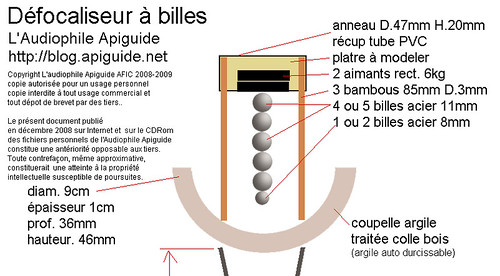WHO CAN USE THE BRODULE
The Brodule can be used by audiophiles and sound engineers who want to hear the true sound recording.
PICTURE OF THE BRODULE
Please see below a picture of my home made Brodule. It has not been polished with sand paper. This is why it looks so "raw". But polishing is only for the outside, it will not improve the sound.
Please see below a picture of my home made Brodule. It has not been polished with sand paper. This is why it looks so "raw". But polishing is only for the outside, it will not improve the sound.


WHAT THE BRODULE IS MADE OF
The Brodule is a cup of modelling clay / paste (air hardened) over which hang 6 steel balls attached to 2 rectangular magnets 6kg strength (one placed above the other). The magnets are attached to a base which is above the cup and rests on wooden barbecue sticks standing in the bottom of the cup.
The cup is placed (a) near/touching the front wall facing the listener, exactly at mid-distance between the two speakers (use a string to measure the distance between the two speakers, then fold it in two to have exactly half of the distance), and (b) the bottom of the cup is at about eye level in the seating position; if this does not work, try higher, but not more than 30cm.
Once you have found the proper placement for the cup (first vertically, ie at mid-distance between the speakers, then horizontally, ie at the correct hight), draw on the wall a vertical line of a few centimetres to remember the position of the steel balls - which form a vertical line, and a horizontal line of a few centimetres to remember the position of the base of the cup. This is very useful should you have to remove temporarily the Brodule and it put back to its original position. It will avoid you to have to spend time to find again the proper placement.
Once you have found the proper placement for the cup (first vertically, ie at mid-distance between the speakers, then horizontally, ie at the correct hight), draw on the wall a vertical line of a few centimetres to remember the position of the steel balls - which form a vertical line, and a horizontal line of a few centimetres to remember the position of the base of the cup. This is very useful should you have to remove temporarily the Brodule and it put back to its original position. It will avoid you to have to spend time to find again the proper placement.
HOW THE BRODULE WORKS
The Brodule is a diffuser. What the Brodule does is to break / diffuse the high frequencies which bounce back from the back and side walls onto the front wall and into the cup; the steel balls receive the high frequencies from the inside of the cup (which acts like a satellite antenna receiving a signal and reflecting it) and break / diffuse them (energy transformed into vibration or heat). It will eliminate flutter echo. On diffusion, see http://en.wikipedia.org/wiki/Diffusion_%28acoustics%29
which indicates that:
"Diffusors (or diffusers) are used to treat sound aberrations in rooms such as echoes. They are an excellent alternative or complement to sound absorption because they do not remove sound energy, but can be used to effectively reduce distinct echoes and reflections while still leaving a live sounding space. Compared to a reflective surface, which will cause most of the energy to be reflected off at an angle equal to the angle of incidence, a diffusor will cause the sound energy to be radiated in many directions, hence leading to a more diffusive acoustic space. It is also important that a diffusor spreads reflections in time as well as spatially. Diffusors can aid sound diffusion, but this is not why they are used in many cases; they are more often used to remove coloration and echoes."
It has some similarities with the Resonators from Acoustic System (device placed against the front wall) but operates differently (no resonance of metal cups, on the contrary, the cup of clay does not resonate at all, the inside thereof reflects high frequencies and direct them towards the steel balls).
See http://www.eqacoustics.com/learn-more/acoustics-for-audioand
http://www.crutchfield.com/S-j5z8Yp3IXo6/learn/learningcenter/home/speakers_roomacoustics.html?page=2
In my mind, the Brodule works better than a Schroeder diffuser. It doesn't take more space than a CD. What you hear is fantastic.
which indicates that:
"Diffusors (or diffusers) are used to treat sound aberrations in rooms such as echoes. They are an excellent alternative or complement to sound absorption because they do not remove sound energy, but can be used to effectively reduce distinct echoes and reflections while still leaving a live sounding space. Compared to a reflective surface, which will cause most of the energy to be reflected off at an angle equal to the angle of incidence, a diffusor will cause the sound energy to be radiated in many directions, hence leading to a more diffusive acoustic space. It is also important that a diffusor spreads reflections in time as well as spatially. Diffusors can aid sound diffusion, but this is not why they are used in many cases; they are more often used to remove coloration and echoes."
It has some similarities with the Resonators from Acoustic System (device placed against the front wall) but operates differently (no resonance of metal cups, on the contrary, the cup of clay does not resonate at all, the inside thereof reflects high frequencies and direct them towards the steel balls).
See http://www.eqacoustics.com/learn-more/acoustics-for-audioand
http://www.crutchfield.com/S-j5z8Yp3IXo6/learn/learningcenter/home/speakers_roomacoustics.html?page=2
In my mind, the Brodule works better than a Schroeder diffuser. It doesn't take more space than a CD. What you hear is fantastic.
ACOUSTIC RESULTS
In summary, you will hear the original parameters of the recording.
With the Brodule, you will focus on the music, not on your sound system.
The detailed results are as follows:
Soundstage: feeling of the acoustics of the place of recording (concert hall or outdoors) i.e. a lot of air, reverberation, depth, huge soundstage being global and coherent, the various instruments which play in the orchestra are audible in detail, and you can follow the part of each instrument, the music players appear to be precisely placed in space and are easily differentiated, a better spreading of the sound in the listening room, more enveloping sound.
Sound: the sounds appear more natural, there is less distortion (i.e. you can increase the volume to some extent without ear pain or discomfort), very clean bass, more bass and sub-bass, the micro-informations can be very well heard, better dynamics, more emotion on certain records especially with voices.
The Brodule seems to produce the same results as a super tweeter. See:http://www.wisegeek.com/what-is-a-super-tweeter.htm
http://www.positive-feedback.com/Issue15/supertweeter.htm
http://www.evmag.fr/site.php?page=audio201
HOW TO MAKE THE BRODULE, DETAILED EXPLANATIONS, READERS COMMENTS
You need very few things to make the Brodule, and it takes very little time to make it (1 hour, 3 days of drying for the cup). Basically, what you have to make is the cup, the rest is nothing.
What you need is:
- Modelling paste (air hardened): see the arts/children handicraft websites): such a paste exists under the name "Fimo Air". You need 500g per cup. For the UK and France, see http://www.greatart.co.uk/FIMOAIRBASICMODELLINGCLAY-modelling-1.htm, http://www.creavea.com/fimo-air-basic-blanc-500-gr_boutique-acheter-loisirs-creatifs_12034.html. For the USA, see: http://www.dickblick.com/products/staedtler-fimo-air-basic-modeling-clay/?wmcp=amazon&wmcid=feeds&wmckw=33284-8141. For any country in the world, see Ebay.
- Steel balls 8mm and 11mm diameter. You can order them on websites
- Rectangular magnets 6kg strength. They come from cupboard magnets (you have to remove the plastic case with a screwdriver). Buy in hardware store or on websites. They look like this: http://www.usinenouvelle.com/expo/aimants-de-placard-bla-p72404.html
- Wooden barbecue stick to be cut in 3 parts of 85mm. Buy in supermarket
- Bottom of bottle of vitamin (see my picture) or plastic cap (eg milk bottle, see my picture). Diameter 47 or 50mm, height 20mm
- Scotch tape to link the top of the device with the magnets and the wooden barbecue sticks
- Tools: ball of 73mm diameter (or very similar diameter), we use in France a Pétanque ball that you can also buy abroad see http://www.playaboule.com/Replacement-73mm-dia-Glo-Bocce-Petanque-ball.aspx, tennis ball to polish the inside after about 7 hours of drying (also use your finger in the end, with a few drops of water if necessary), a bowl with an inside round bottom (eg Chinese bowl) to use as a mold for the outside of the cup
- to put each of the bowl, the ball, in a separate plastic bag so that they don't stick with the paste
- to push the 73mm ball in the paste only to half depth (ie 36mm)
- to make the ball turn in its plastic bag, so as to have a polished inside of the cup. In order to enable a smooth polishing and turning, add a few drops of water
- to make a cup that is between 1 and 2.5cm thick (when you view the cup from above, the thickness is the distance between the external part and the internal part of the cup). The diameter of the inside of my cup (viewed from above) when it's dry is 65mm. So about the diameter of a tennis ball, and a bit less than the diameter of the ball of 73mm I used at the beginning of the process. So perhaps you can just use a tennis ball, provided that you comply with item 9, i.e. the depth of the inside of the cup must be 36mm.
- to make a compact cup (if you see cracks, put the paste back in the bowl and press hard)
- to make at least 2 cups, perhaps 3. For the first one, you will get used to making it, but it may not be perfect. Your second or third one will be perfect. With the Fimo Air paste, you need one bag per cup
- to check with a stick that the depth of the inside of the cup is 36mm
- to let the cup dry in the air for 3 days, first bottom up, then bottom down
- to use 5 steel balls of 11mm on the top, and then 1 steel ball of 8mm on the bottom. It is very important that the steel balls are exactly above the center of the cup, otherwise the Brodule will not work.
- to place the cup of the Brodule touching the front wall (starting position, and you can try moving it backwards but not more than 5 cm), and the bottom of the cup at about eye level in the seating position
- If after drying, you see that the inside of the cup has cracks (it can happen after a few months, especially in the summer season when the weather is very hot and dry), you can repair this just by putting a few drops of water, and polishing with a finger. Then, throw away the excess water and let dry for a few hours.
THIS BLOG IS CONTINUOUSLY UPDATED SO VISIT IT OFTEN TO SEE THE LATEST IMPROVEMENTS
I urge the readers to have a look at the following descriptions (in French only, but you can have the web pages automatically translated by Google), comments and pictures, and to make their own Brodule:
1) The Instruction Manual by Audiophile Apiguide
http://www.apiguide.net/images-audio/defocaliseur-a-billes-brodule.pdfThis is the abridged manual. If you want the full manual, it is necessary to order the CD made by the Audiophile Apiguide (the CD contains all the tweaks developed by Audiophile Apiguide over 40 years), which only costs a small amount of money. You can manage to build the Brodule without the full manual, the abridged manual and my explanations may be enough, but the CD can give you useful additional details.
Please also see the Audiophile Apiguide's blog (which has a "Google Translate" tool incorporated therein):
http://blog.apiguide.net/archive022.htm
2) My comments, my proposed simplifications in the manufacturing process, the readers commentshttp://lebrodule.blogspot.fr/2013_12_01_archive.html
http://ambiance-hifi.fr/viewtopic.php?f=3&t=8277http://www.audio-conseil.com/Forum/viewtopic.php?t=1319
We support Real Stereo from Alan Blumlein
See:http://www.tnt-audio.com/topics/realstereo_e.html
http://en.wikipedia.org/wiki/Alan_Blumlein
